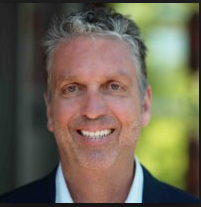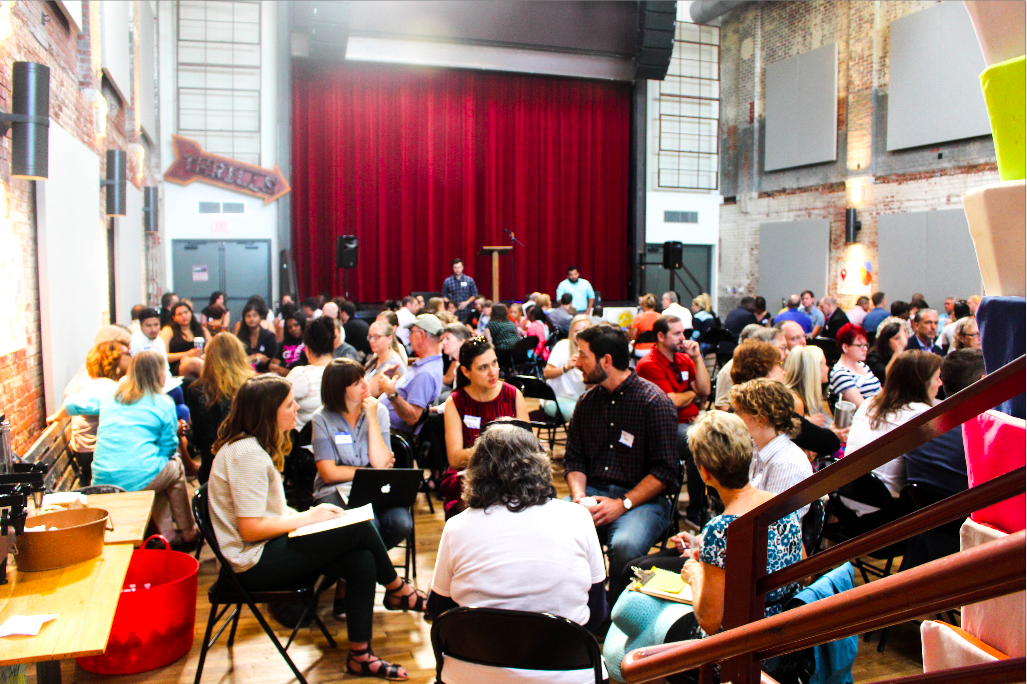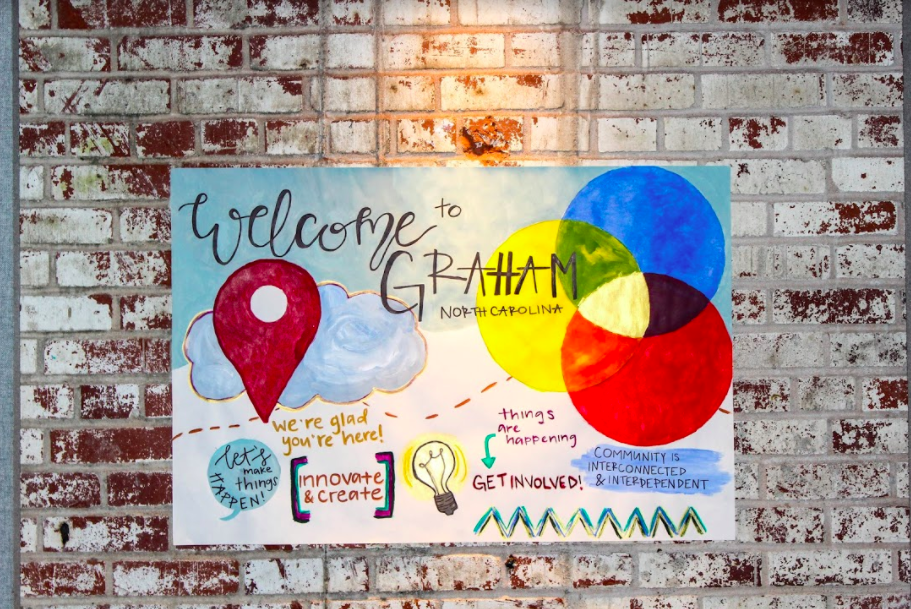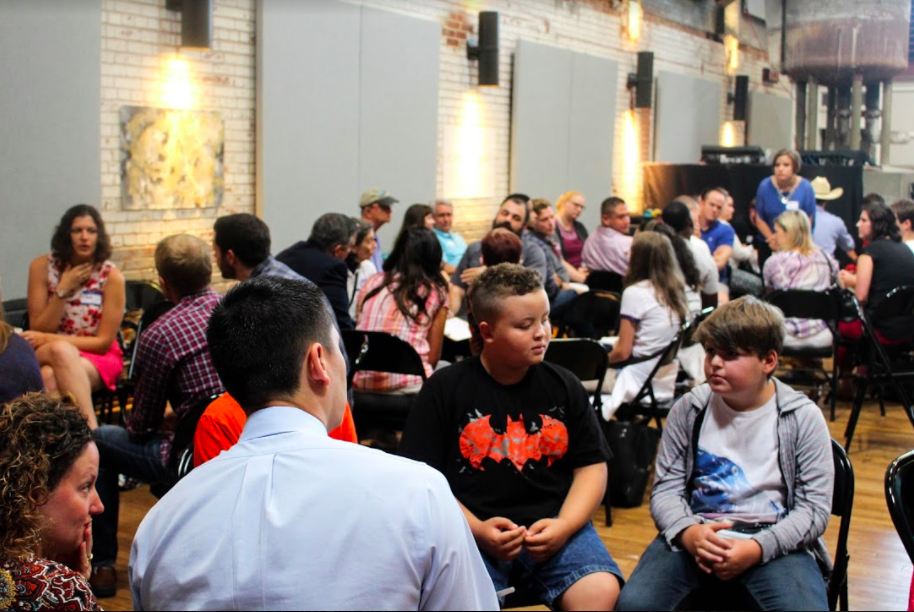engage alamance: part 3
ACTION > CONVERSATION
On August 15th, about 150 people who care about Alamance County started taking action for their community. Here's a recap of our morning.
JASON COX:
First and foremost, I want to say thank you to Tom and Heather LaGarde for allowing us to use this beautiful space in Saxapahaw for our third Engage Alamance. I would say we easily have four to five times what we had at the first one, so it’s great to be able to fill a space like this. I also want to thank the Hayden Harman Foundation, Bob and Kathy Hykes, Samet Corporation, and especially Impact Alamance, who’ve been very strong partners in CoOperative’s first year. I also want to say to Ian Baltutis, Katie Chung, Paul Koonts, Griffin McClure, Nathan Page, Claire Haslam, and many other I’m sure I’m going to forget, thank you for being such early, dedicated supporters of CoOperative, of its mission, and of this series. You and other have been a great resource as we’ve started to build a team. Thank you for being both participants, but mostly thank you for being habitants. I appreciate it.
So, as I was thinking about this event, I spent a lot of time thinking about mindset, thinking about people’s default starting point when it comes to their life or decisions. Now, we’re all unique little snowflakes, we all have a different viewpoint, but overwhelmingly we tend to start from one of two viewpoints: we either approach things from the scarcity mindset, or we approach them from the opportunity mindset. Now a scarcity mindset looks at a situation from the viewpoint of an expense or a risk. It’s a problem that carries a possibility of loss. So the immediate effort is to mitigate that risk at all costs. Resources, whatever they may look like, are looked at like a pie that is being cut up, where one piece of the pie for someone else means less for them. An opportunity mindset looks at situations as just that. It is an opportunity. Now, of course, there’s risk.
There’s always the possibility of failure and there will be obstacles to overcome, unknown pitfalls along the way, but there’s also the opportunity to create something that is better than what you started with or what you may have been left with from a prior generation. You can make the pie bigger. Or better yet, add a cake. Or you can get really creative and come up with a whole new thing, like cronuts, for example.
I’m from a small rural town in eastern North Carolina called Snow Hill. Raise your hand if you actually know where Snow Hill is. So we took a map of North Carolina and found Greenville, Kingston, Wilson, and Goldsboro, and sort of drew a circle using those. There’s an empty spot in the middle where Highway 58 and 13 intersect. That’s where I’m from. Now, when I was growing up, the primary industry was tobacco. The only real noticeable change from last time I went back is there’s less tobacco and more soil. There are 21,000 people in the whole town. The poverty rate is 33% higher than it is here in Alamance. It lost 2.5% of its population just last year. In fact, the average income went down almost 10% in the past twelve months. There are no place-based assets or notes of leverage in Greene County. There’s no infrastructure left over from other industries to be repurposed for a new century. I know what scarcity looks like. I know what a lack of opportunity really is. I think this county for, to be honest, decades, has operated from a scarcity mindset. That often times, it’s been more about minimizing loss and trying to fill the holes that were left from that loss. To try to get a piece of that pie, and to make sure we don’t lose any more in the meantime. Now, this county has its risks. It lacks the state and a lot of really important metrics. Its schools and its educational system need to be looked at as investment that’s being made for generational return, not an item on a balance sheet that needs to be minimized. It suffers from a lack of place attachment for a lot of its members, a common problem in what we would call an overwhelmingly bedroom community.
But Alamance County has ended up, sometimes with intent, sometimes just due to circumstance, with a whole lot of opportunity. It has an evolving agricultural economy, that’s well situated to take advantage of growing emphasis on local and regional food droughts, and to create new industries around food. It sits exactly in the middle between the second and third largest population centers in the state. With interstate access and infrastructure that no amount of money could rebuild today. It also has numerous place-based assets, ready for repurposing.
We’re standing in one of them right now. Saxapahaw is the story of repurposing place based assets for a new century. To be revitalized with intent implanting, to build new innovative industries around and help develop a new era local entrepreneurship. We have our best resources here. For a county of 160,000 creative, engaged people, that have the possibility of creating new, engaging ideas. So, we don’t have an opportunity problem, we have an action problem. The simple truth is that starting is the first step. We can start now, we can start next week, we can start next year. The only difference will be what change and when. Now, I always let people know that I have absolutely zero experience in non-profits, which is a terrible sales pull. So I admit the irony of being the founder of one, but I have been adamant since the beginning that CoOperative would be first and foremost an entrepreneurial, action-oriented organization. That we would seek to focus on where we could create impact, and do things that aren’t safe, that weren’t proven, and that we wouldn’t shy away from challenged. So, mission-driven, entrepreneurial, collaborative: great buzzwords used in every single company and non-profit website you can find. But to me, these words are kind of like ideas for a startup.
You know what the value of an idea in a startup? Zero. Its execution, its action. For every start-up, you need a first mover. It’s a customer who buys your product for the first time, validates that it is of value, and convinces others tag along. And CoOperative is in fact that start up. We have a mission of developing an engaged entrepreneurial community and an approach that we think is strong based on creating, connecting, and investing in the community.
So for CoOperative, it has been about finding people who understand that value. Now Buckner companies, Doug, Mike, and others, were really one of the first local companies, out of a lot, and I mean a lot, and organizations that reached out to me. And we talked about what we were doing, what we building, what our mission was. But it was Doug that was the first to really, really get the idea. It didn’t have to be explained three or four times using the right language. He just got it. That the DNA of CoOperative wasn’t really that far away from Buckner’s own. It was about a culture that was willing to push back. It was about a culture that was willing to test old ideas against new ways of doing things. And it was an organization that understood both its responsibility to and its potential to have an impact, if it chose to, on its community. The other thing that was good for me was he understood that we were not talking about emotional philanthropy. We were approaching this as an investment that expects that the mantra will return with the community invested in it. Most importantly for somebody like me, he understood that what you do matters a whole lot more than what you say. So there’s no point in the sentence when we talked a while back about what comes next where we spend a ton of time of minor details. We talked about where we are as a county, our respective visions of it, and then we set upon what we thought might be the right first step to go down that road. Now I’m happy to be able to say today, here and now, that Buckner Companies has chosen to be a significant, early sponsor for CoOperative and its mission, providing valuable staff funding, that’ll help us to both accelerate and increase our efforts in this regard. But even more than their financial support, I’m proud to be able to say we have a corporate partner that genuinely shares our core values around community development and building a sustainable business.
So at this time, I’ll raise the microphone up, and if you can invite Mr. Doug Williams, we’ll ask him to share his vision, and most importantly, his challenges to our community going forward.
Doug Williams:
Good morning. As a resident of Saxapahaw, I’d like to welcome you here today. I’m Doug Williams. I’ve been very involved with the physical development of the Upper Mill Business and the residential project here in Saxapahaw for the past ten years. Along with my partner Claire, and a number of other key community individuals. But possibly, in my mind, more importantly, than the physical, I feel like my partner Claire and I, along with these other key people, have been deeply involved with community building here in Saxapahaw. Also, recently, Claire and I have been drawn to Graham and the vision of similar community building there. My day job as a CEO of Buckner Companies, located about halfway between here and Graham, employing roughly 450 people. Over the last thirty-something years, being a transplant from Orange County, the Chapel Hill area, Alamance County has become home to me and a home to our business. I have to admit, I haven’t always been a fan of Alamance County. I haven’t been a fan many times of the county’s vision. I haven’t been a fan many times of the county’s development forces. Generally, when I entertain customers or prospective transplanted job candidates, I do either in Saxapahaw, Carrboro, Chapel Hill, or even in Durham, sharing with them the amenities, the forward-thinking communities, and their attractive quality of life. I can tell you they’re consistently impressed.
If these statements make you uncomfortable in any way, then I think we’re off to a good start. Normally, I’m not a confrontational person, but I feel today that we need a little lack of comfort to allow us to consider change. Change rarely happens when people are comfortable. Most importantly, actually going beyond considering change, is showing up and actually participating in the change. Participating financially, energetically, and in other meaningful ways.
Please spend a few minutes with me this morning being open-minded and being curiously uncomfortable. I ask you to consider the following facts and opinions. 98% of worldwide CEOs believe their current business models are only sustainable for the next three to five years. Since 1955, 90% of the Fortune 500 have gone away. There’s only one left on the list. Using conventional wisdom to predict future results in the new century is an innovation killer. The rules just don’t hold up anymore. At best, conventional wisdom will result in conventional results. Great companies, great movements, lose out because they have a rowboat mentality. Always looking back to past successes, accomplishments, and methods with awe and admiration while they blindly row into the future. “If it ain’t broke, don’t fix it” for the complacent, the arrogant, stare. Risk aversion is a killer of the greatest opportunities that come when one takes a leap of faith. I’ll give you a couple of examples. A number of years ago, Toyota, before they located in the U.S., invited Ford to visit their plant. Ford went over and found the plant of scarce and so small, so underfunded, that they actually thought it was a staged event. They never recognized that this was actually their first view of lean manufacturing. They were so sure they already knew what a plant should look like. Their inability to see another way resulted in U.S. automakers falling to the 90% mark to less than 40%.
Ten years ago, Yahoo had a chance to buy Google for five billion dollars. At the time, this was only 10% of the then value of Yahoo. The CEO thought it was too risky. Google is now worth an estimated six hundred billion dollars. And by the way, Yahoo recently sold for less than five billion dollars and is no longer a stand-alone business. I contend that Alamance County should, in contrast to the above examples of limited thinkers, adopt an inventive way of thinking and act upon it. I was really happy to hear Jason use the word ‘reinvent’. That’s a phrase I really like. An inventor, or a re-inventor, is someone that does not take what he knows too seriously. In other words, inventors are people who can let go of their expertness and achieve what Steve Jobs called ‘the likeness of being a beginner.' This is tough on governmental bodies and politicians to lead the way on. It’s hard for them to be risk takers. Therefore, the people need to encourage this, and our larger local businesses need to step up and help fund and guide the first examples of risk taking so that governmental bodies can become comfortable and follow suit. However, along this initial path, the governmental bodies do need to do what they can to allow these privately supported efforts to move forward unimpeded.
So this morning, I’m asking that other businesses show up and do something out of their comfort zone in supporting other entrepreneurial, community-based initiatives so to become reality through your energetic and financial support. I can tell, just as in almost every aspect of life, it’ll come back to you. In one way or another, it’ll come back to you.
I'm asking politicians and governmental bodies to allow these initiatives to move forward in the most unencumbered manner. I’m asking the people to show up, in every way possible. Be involved, support these initiatives, support risk taking, and encourage government to accept risk and take these leaps of faith.
I will take a minute to reflect on the success of Saxapahaw. In Saxapahaw we started with an existing community -- just as all of Alamance has. We took great risk, we had few government hurdles or help, we did not limit our thinking and certainly did not focus on the past. We did focus on the key local needs of a quality of life and the businesses to enhance that life -- all with a community focus. We sought to welcome all people of all types and prosper from our uniqueness and from this we generated over 15 new businesses with over 150 new jobs. There are 10 towns and 5 recognized communities, of which Saxapahaw is one of these, in Alamance. If we could repeat this success think about the numbers -- but if done correctly, think about the livability upgrade.
And by doing so the snowball begins.
Young, talented people choose to stay here and move here. Unique, significant employers see this as a spot to locate. Community leads the way and our quality of life a national model. All because we showed up, took risks, and thought differently.
Join me for a day in a vision of the future in Alamance County:
Wow... The designated cycling corridor connecting the towns of Guilford, Alamance and Orange counties felt alive with activity as I road into Graham this morning. Many said a separate bike trail of its own was way too big of a risk from an investment standpoint, but as it panned out the CC -- the cycling corridor -- as it’s called, along with a complementing bus system has been key to development. It felt so good as I pedaled through revitalized Melville this morning, seeing the community businesses opening for what will be another busy day is the counties newest gem. Another really cool reminder along the CC is the unique high density living situations. You see the old school thinkers assumed rural landowners would never allow the CC to pass through their land, but then they realized the adjoining land now had greatly increased values by being attached to one of the nation’s foremost bikeable live/work situations, much like life in Holland with folks enjoying access to jobs and amenities in town, just a healthy pedal removed from a countryside home.
This ‘risky’ investment put us on the map you might say. Young, talented people, cutting edge businesses, ‘change the world’ think tanks, non-profits and independent innovators suddenly saw Alamance County as the center of an out of the box, forward thinking sustainable community based living opportunity, and the rest just seemed to occur. But actually, better said, organically lead the way with multiple initiatives feeding the momentum along the way to reaching this 10-year goal. Heck, most of it occurred in closer to 5 years. Initiatives including the revitalization of existing commercial and residential spaces, support and encouragement of energetic entrepreneurs, small local businesses and sustainable communities. This was key to attracting the bigger employers to move here because of the livability for their current and future employees and associates. And all within a very inclusive diversified population. It didn't just happen on the backs of government, certainly local government shifted priorities to support both in action and monetarily, but not until the people spoke up and showed up and long standing Alamance County businesses invested meaningful financial support that frankly woke the politicians and governmental bodies up to looking forward not backwards, taking risks for future generations -- we even had the full support of gubernatorial candidate Ian Baltutis!
I could go on about the restaurants, activities, and overall quality of life that has developed -- wow, Alamance is now my go to spot for entertaining prospective customers and employees! The tax base, resulting in better schools, local food base, an influx of young energetic people, a real sense of community...
But I'm distracted...
It's such a nice day here on the courthouse square as I drink from the freedom fountain where that dreaded statue used to stand. No need to lock my bike in the rack, we're a community with mutual respect for all people and wow, ALL people are truly showing up.
So in closing, I’ve given you an example of a vision. I'm not saying it's the vision but it certainly has elements that I believe are key parts of a potential vision.
I've asked you to show up, especially the businesses, to take risk, to see the value in the backdrop that binds it all together -- the community, the small businesses, restaurants, trails, markets, coffee shops, outdoor spaces, walkable areas, and amenities that make an area not only livable but a community with quality interactions.
Make these new spaces welcoming to all people of diversified races, genders, backgrounds, and lifestyle preferences. And finally, please take down that statue in Graham so we can all move forward together as a community.






